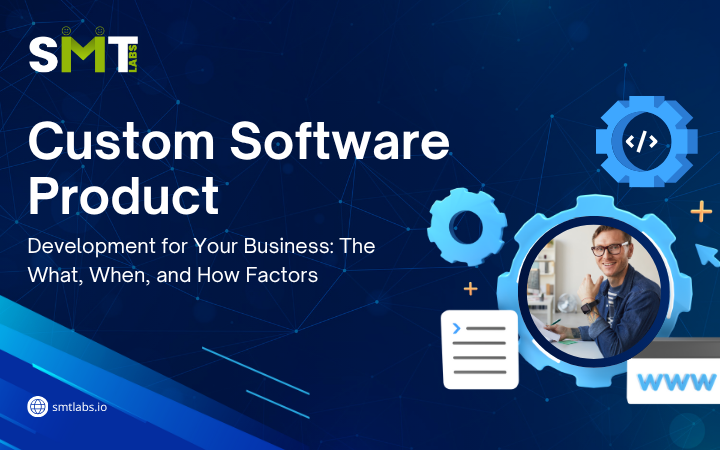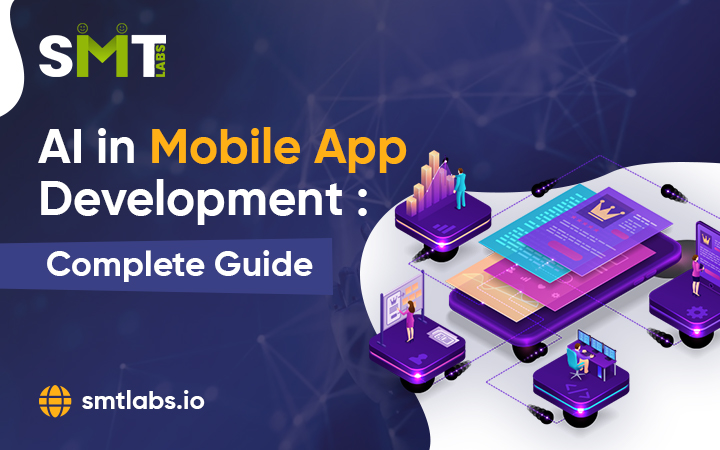Custom Software Product Development for Your Business: The What, When, and How Factors

In today’s hyper-competitive digital economy, software isn’t just a tool — it’s the foundation of business innovation. Whether you’re running a startup, a mid-sized enterprise, or a multinational corporation, your ability to solve unique problems and deliver seamless user experiences often depends on how well your software aligns with your goals. Off-the-shelf software can serve as a temporary fix, but it rarely fits like a glove. That’s where custom software product development enters the picture — transforming ideas into intelligent, scalable, and profitable digital products.
Think about the most successful businesses you know — from Uber to Airbnb to Shopify. None of them relied on ready-made tools. Instead, they built software uniquely designed for their business models and user needs. This ability to build, iterate, and own their platforms sets them apart.
At SMTLabs, we believe custom software is not just about coding. It’s about building a product strategy that turns your vision into a valuable, revenue-driving asset. In this blog, we’ll break down the What, When, and How factors of custom software product development — helping you understand what makes it essential, when it’s the right move, and how to execute it effectively.
What Is a Custom Software Product?
Simply put, custom software (or bespoke software) is a solution designed specifically for your business needs rather than a general-purpose product available to anyone. Unlike off-the-shelf software — think Salesforce, Trello, or QuickBooks — a custom solution is crafted around your workflows, users, and goals. It’s your intellectual property, your competitive advantage, and your business backbone rolled into one.
Custom software can be anything — a web platform that manages operations, a mobile app that connects customers, or an AI-powered tool that automates complex processes. The defining factor is fit. It aligns perfectly with how your business operates rather than forcing you to adapt to generic features.
Custom vs. Off-the-Shelf Software
Let’s visualize the difference:
| Feature | Off-the-Shelf Software | Custom Software |
| Ownership | Vendor-owned | You own it fully |
| Flexibility | Limited customization | Fully tailored to your needs |
| Cost (initial) | Lower upfront | Higher upfront |
| Cost (long term) | Subscription-based, accumulative | One-time build, long-term ROI |
| Integration | Often limited | Built to integrate with your systems |
| Scalability | Vendor-restricted | Scales as your business grows |
| Security | Shared environment | Built with your security protocols |
Off-the-shelf tools are like renting an apartment — easy to move in but never truly yours. Custom software, on the other hand, is like building your dream home — an upfront investment that pays off with time, comfort, and control.
Key Features & Characteristics of Custom Software
A well-designed custom software product goes beyond surface-level customization. It embeds your company’s DNA into every feature. Here are the defining characteristics:
1. Tailored to Your Workflows
Every organization operates differently. What slows one team down might be a strength for another. Custom software adapts to your processes instead of the other way around. It automates the repetitive, simplifies the complex, and delivers exactly what your users need — no unnecessary bloatware or irrelevant buttons.
2. Scalable and Flexible
Custom software grows as you grow. Whether you’re expanding to new markets, adding users, or launching new services, your platform can evolve without major reengineering. Unlike off-the-shelf tools that restrict scaling through pricing tiers, your custom system can expand seamlessly.
3. Ownership and Control
When you build custom software, you own the source code and the intellectual property. That means no licensing restrictions, no dependency on vendor timelines, and full control over security and updates.
4. Seamless Integration
Businesses today use a web of systems — CRMs, ERPs, HRMs, and analytics tools. Custom software acts as a central nervous system, integrating everything smoothly. APIs, cloud services, and data pipelines can be woven together to provide real-time visibility and operational efficiency.
5. Enhanced Security
Security is a top priority in the digital age. Custom software allows you to implement encryption, access controls, and compliance standards tailored to your industry — whether it’s GDPR, HIPAA, or PCI DSS. Unlike shared SaaS solutions, your data remains protected in a private environment.
6. Competitive Advantage
When your technology does exactly what you need — and your competitors are stuck adjusting to prebuilt systems — you win. Custom software provides a strategic edge by aligning technology with your business strategy, enabling faster innovation and unique customer experiences.
Types and Use Cases of Custom Software
Custom software can take many forms depending on your industry and goals. Below are some of the most common types businesses invest in:
1. Internal Enterprise Tools
These are solutions built to streamline operations within the company — think employee portals, project management dashboards, or automated reporting systems. They help reduce inefficiencies and boost productivity.
2. Customer-Facing Platforms
This category includes web or mobile applications that interact directly with your customers — e-commerce stores, SaaS platforms, booking systems, and loyalty apps. They define how your customers experience your brand.
3. Industry-Specific Solutions
Every industry has unique challenges. Manufacturing companies may need production tracking systems, healthcare organizations may require patient management platforms, and logistics firms rely on shipment tracking software. Custom development ensures compliance and fit for these specific cases.
4. Data-Driven and Analytical Tools
Custom dashboards and business intelligence tools allow businesses to harness their data for strategic decision-making. They consolidate data from multiple sources, visualize insights, and support predictive analytics.
5. Integration Middleware
Some companies don’t need a new system but a way to make existing systems communicate better. Custom middleware bridges this gap — syncing data between platforms and creating a unified ecosystem.
6. Customer Portals and Self-Service Platforms
Self-service systems empower customers and reduce manual support costs. Examples include banking apps, insurance portals, and subscription management tools.
At SMTLabs, we’ve built everything from fintech solutions to healthcare analytics platforms — each crafted with the client’s vision, scalability, and long-term ROI in mind. The common denominator? A commitment to solving real business problems through intelligent software.
Why Ask “When”? – The Importance of Timing in Custom Software Development
Before investing in a custom product, timing is everything. Many businesses rush into development because they want to innovate quickly, only to realize they aren't ready — or they wait too long and lose their competitive advantage. Understanding when to build can make the difference between a successful product and an expensive misstep.
Businesses should evaluate readiness across three key dimensions:
- Business Readiness – Are your processes mature enough to define requirements clearly?
- Market Readiness – Is there a proven need or demand for your idea?
- Resource Readiness – Do you have the budget, talent, and time to commit to development?
When these three align, that’s your signal to start building.
Signs You Need a Custom Software Product
Here are some clear indicators that your organization is ready — or even overdue — for a custom software solution:
1. You’re Outgrowing Off-the-Shelf Tools
You’ve stretched Excel, QuickBooks, or your CRM as far as they’ll go. Custom workflows require complex hacks or manual processes. That’s a strong sign you’ve outgrown generic tools.
2. Your Systems Don’t Talk to Each Other
Data is scattered. You’re spending hours reconciling information between sales, inventory, and finance. A custom solution can unify all your systems into a single, integrated ecosystem.
3. You Need a Competitive Edge
If your industry is crowded, having proprietary software can be your differentiator. It enables faster service, personalized user experiences, and operational efficiencies others can’t replicate.
4. You Have Unique Business Logic
Some businesses operate in ways that simply don’t fit standard software. Maybe your pricing model, workflow, or compliance rules are unique — that’s when custom development becomes essential.
5. You’re Scaling Rapidly
When user bases grow quickly, off-the-shelf platforms often struggle with performance and licensing limits. Custom software allows you to scale on your own terms.
When to Hold Off on Custom Software Development
While custom software offers unmatched flexibility and control, it’s not always the right move — at least, not immediately. Jumping into a full-scale development project too early can drain your resources, divert focus, and lead to a product that doesn’t align with your evolving business model. Sometimes, waiting is the smartest strategy.
Here are key scenarios where holding off on custom development might save you time and money:
1. You’re Still Validating Your Business Idea
If your product or service is still in the “concept” phase, investing in custom software can be premature. At this stage, it’s smarter to test the market using low-cost tools or no-code platforms. Once you’ve proven demand, then you can transition into building your own product with confidence.
2. You’re Lacking Internal Alignment
Custom development requires collaboration across departments — marketing, operations, IT, and leadership. If your team doesn’t have a unified vision of what the software should achieve, you risk building a fragmented system. Waiting until there’s clear alignment ensures better outcomes.
3. Your Business Processes Aren’t Defined Yet
Custom software is built around your existing workflows. If those workflows are still evolving or inconsistent, you may end up automating inefficiencies. Take the time to map and optimize your processes first.
4. Off-the-Shelf Tools Cover Most of Your Needs
If you find that ready-made software already meets 80–90% of your operational needs, customization might not justify the investment. Instead, focus on integration or slight customization before moving to a full custom build.
5. Budget or Resources Are Limited
High-quality software development requires investment — not just in money but also in time, people, and ongoing maintenance. If your current resources are stretched thin, it’s better to plan strategically than to build in haste.
At SMTLabs, we often advise clients to start small — perhaps with an MVP (Minimum Viable Product) or prototype — before scaling to a full custom solution. It’s all about balancing ambition with timing.
How to Develop a Custom Software Product
Once you’ve decided that custom software is the right move, the next step is figuring out how to make it happen effectively. Successful development isn’t about coding first — it’s about strategy, collaboration, and iteration.
At SMTLabs, we follow a structured yet flexible approach that ensures each stage delivers measurable value. Let’s explore the major phases.
1. Pre-Development and Discovery Phase
The foundation of a successful software product lies in discovery — understanding what to build and why. Many projects fail because this phase is rushed or skipped altogether.
Key Steps:
- Requirement Gathering:
Engage stakeholders to identify goals, challenges, and success metrics. This ensures that everyone’s expectations are aligned before development begins. - User Research:
Study user behavior, conduct interviews, and analyze data to understand pain points and preferences. Remember, good software solves real user problems. - Business Analysis & MVP Definition:
Break down the “must-have” versus “nice-to-have” features. Define an MVP that delivers maximum value with minimum complexity. - Technology Evaluation:
Choose the right tech stack based on scalability, performance, and long-term maintainability — whether it’s React, Node.js, Python, or cloud-based solutions like AWS or Azure. - Architecture & Roadmap:
Design a flexible architecture that supports future growth. Plan a roadmap outlining milestones, timelines, and budget estimates.
The goal of this phase is to de-risk development. The clearer your discovery process, the smoother your build phase will be.
2. Development and Delivery Phase
With a clear roadmap in hand, the next stage is bringing your vision to life. This phase is where design meets engineering — transforming concepts into working software.
Agile and Iterative Development
Rather than building everything at once, Agile methodology breaks development into short cycles (sprints), each focusing on a small, functional piece of the product. This approach ensures flexibility, faster feedback, and reduced risk.
Key Activities Include:
- UI/UX Design:
Great software isn’t just functional — it’s intuitive. Design teams focus on creating user-centric interfaces that feel natural and engaging. - Prototyping:
Before full-scale coding, interactive prototypes are created to validate design flow and gather feedback early. - Coding and Implementation:
Developers build the front end, back end, and database components, ensuring scalability and reliability. - Quality Assurance (QA):
Rigorous testing — including functional, performance, and security testing — ensures the software works flawlessly before launch. - Documentation:
Proper documentation of code, APIs, and user guides helps with future scalability and onboarding.
This phase is where collaboration between developers, designers, testers, and clients is crucial. At SMTLabs, our Agile approach ensures weekly progress updates, demo sessions, and continuous integration pipelines for transparency.
3. Deployment, Maintenance, and Growth
The journey doesn’t end at launch — it evolves. A great software product is one that continually adapts to user feedback and market shifts.
Deployment:
Before release, the software goes through a staging environment where final testing, user acceptance testing (UAT), and performance optimization take place. Once approved, it’s deployed to production with robust backup and rollback strategies.
Maintenance:
After deployment, ongoing maintenance ensures system stability, updates, and security patches. Continuous monitoring tools track performance, detect issues, and ensure uptime.
Growth and Scaling:
As user adoption increases, features are refined, new modules are added, and infrastructure is optimized. This is where analytics play a key role — helping you decide where to focus next.
Custom software should never be static. It’s a living product that evolves alongside your business and user expectations.
4. Choosing the Right Development Partner
Finding the right software development partner can make or break your project. Whether you’re building internally or outsourcing, the key is choosing a team that aligns with your vision, culture, and communication style.
In-House vs. Outsourcing vs. Hybrid
- In-House: Full control but requires heavy investment in hiring, training, and managing technical staff.
- Outsourcing: Cost-effective and gives access to specialized talent. However, communication and cultural alignment must be managed.
- Hybrid: Combines the control of in-house teams with the flexibility and scalability of outsourcing partners — a popular choice for many growing companies.
What to Look For in a Partner
- Proven track record in your industry
- Technical expertise across relevant tech stacks
- Transparent communication and project management
- Strong post-launch support and maintenance policies
- Understanding of your business goals, not just technical requirements
At SMTLabs, we emphasize partnership over projects. Our team becomes an extension of yours — ensuring clear communication, shared goals, and measurable outcomes every step of the way.
Cost, Time, and Risk Factors in Custom Software Development
Building custom software is a significant investment — but one that pays off in long-term efficiency, scalability, and competitive advantage. Understanding the key factors that influence cost, timelines, and risks helps you plan better and avoid common pitfalls.
1. Cost Drivers
Custom software costs depend on several elements:
- Complexity of Features: Advanced logic, AI integration, or multi-user workflows increase development time.
- Technology Stack: Some technologies require specialized expertise that can affect cost.
- Design Requirements: Complex UI/UX elements or animations can add to development hours.
- Integrations: Connecting third-party systems (like CRMs, payment gateways, or APIs) requires additional work.
- Security & Compliance: Data-heavy industries (finance, healthcare) must invest more in security architecture.
2. Time Estimates and Phasing
Typical timelines vary depending on scope:
- Discovery & Design: 2–6 weeks
- Development & Testing: 3–6 months for MVPs, 6–12 months for enterprise systems
- Deployment & Optimization: 2–4 weeks
Breaking the project into phases helps control cost, test assumptions, and deliver incremental value.
3. Risk Management
No project is without risk, but awareness helps you prepare:
- Scope Creep: Keep documentation tight and use change control.
- Unclear Requirements: Ensure discovery is complete before coding.
- Technical Debt: Avoid cutting corners during development.
- Vendor Dependence: Use open standards and ensure full access to source code.
A strategic approach, clear communication, and ongoing feedback loops dramatically reduce risks.
Best Practices & Tips for Successful Custom Software Development
Building a custom software product is a marathon, not a sprint. While every project is unique, certain principles consistently separate successful builds from the rest. Whether you’re working with an internal team or an external partner like SMTLabs, following these best practices ensures your software not only works — but thrives.
1. Maintain a Clear Scope and Vision
It’s tempting to add new features during development, but scope creep can derail progress and inflate costs. Start with a crystal-clear vision of the problem you’re solving and who you’re solving it for. Define core features first, and keep a roadmap for future enhancements.
2. Build for Scalability from Day One
Even if you’re starting small, your software should be designed to grow with your business. Modular architecture, cloud-based infrastructure, and API-driven development allow easy expansion later on without costly rewrites.
3. Prioritize UX (User Experience)
Users don’t just interact with software — they experience it. Prioritizing a smooth, intuitive interface ensures adoption, retention, and satisfaction. Always test with real users early and often to refine the experience.
4. Leverage Agile and Continuous Feedback
Adopting an Agile development process means you’re not waiting months to see progress. Delivering incremental updates, gathering feedback, and iterating quickly ensure that the product evolves in sync with your goals.
5. Automate Testing and Deployment
Incorporate DevOps practices such as Continuous Integration (CI) and Continuous Deployment (CD). Automated testing and deployment pipelines save time, reduce human error, and enable faster releases.
6. Ensure Data Security and Compliance
Data is the lifeblood of any modern business. From encryption and user access control to compliance with industry regulations, build security into every stage — not as an afterthought.
7. Keep Communication Transparent
Communication breakdowns are the root of most project failures. Use collaboration tools, set up weekly progress calls, and ensure both technical and business stakeholders stay aligned throughout the development cycle.
8. Document Everything
From architecture decisions to user manuals, comprehensive documentation ensures your software remains manageable, scalable, and transferable — even when teams change.
9. Don’t Neglect Post-Launch Support
Software isn’t done at launch. Regular updates, performance monitoring, and continuous improvement keep your product relevant and competitive.
At SMTLabs, these principles are baked into our workflow. Our team approaches every project as a partnership — focused on delivering measurable business results, not just lines of code.
Measuring Success: KPIs and Performance Metrics
Launching custom software is only half the story; understanding its impact is the other half. Without tracking results, you won’t know whether the investment is paying off. The best way to measure success is through Key Performance Indicators (KPIs) tailored to your business objectives.
1. Adoption and Engagement Rates
Track how many users are actively using the system and how frequently. If adoption is low, it might signal usability issues or a need for better onboarding.
2. Productivity Improvements
If your software was designed to streamline operations, measure time saved, reduced manual effort, or fewer errors. For example, automating reporting may save your team 20+ hours a week — a direct ROI indicator.
3. Customer Satisfaction (CSAT & NPS)
For customer-facing software, monitor user satisfaction through surveys, reviews, and feedback forms. A rising Net Promoter Score (NPS) indicates users find real value in your product.
4. ROI (Return on Investment)
Calculate ROI by comparing cost savings, new revenue streams, and operational improvements against the total investment in development and maintenance.
5. Performance Metrics
Downtime, page load speeds, and transaction success rates are technical KPIs that directly affect user experience and brand trust.
6. Scalability and Flexibility
Monitor how well your system handles growth — increased users, data, or transactions — without performance degradation.
By setting measurable goals from the beginning, you’ll be able to justify your investment, optimize for better outcomes, and ensure your software continuously delivers value.
Real-World Examples & Case Studies
Let’s look at how real businesses leverage custom software to transform their operations and outpace competitors.
Case Study 1: A Logistics Company Streamlines Operations
A mid-sized logistics firm struggled with outdated spreadsheets and manual dispatch tracking. SMTLabs developed a custom logistics management platform integrating fleet tracking, route optimization, and driver communication.
Results:
- 40% reduction in fuel costs
- 60% faster delivery scheduling
- Real-time visibility into operations
The new software didn’t just digitize processes — it transformed the company’s entire logistics strategy.
Case Study 2: A Healthcare Startup Enhances Patient Care
A healthcare startup wanted to create a HIPAA-compliant telemedicine app that connects doctors and patients securely. SMTLabs built a custom telehealth platform featuring video consultations, digital prescriptions, and secure data storage.
Results:
- 3x user growth in 6 months
- 95% satisfaction rate among patients
- Compliance-ready infrastructure for scalability
These examples highlight how custom software development creates long-term strategic advantages — improving efficiency, enabling innovation, and building brand differentiation.
How SMTLabs Approaches Custom Product Development
At SMTLabs, we don’t just build software — we build digital success stories. Our process is refined, transparent, and deeply collaborative, ensuring every solution aligns with your goals and market realities.
1. Discovery-Driven Approach
We start by deeply understanding your business — your pain points, audience, and desired outcomes. Our business analysts and architects work with you to define a clear roadmap that minimizes risk and maximizes ROI.
2. Agile Execution
We operate in Agile sprints, delivering incremental value every two weeks. You get to see, test, and refine the product as it evolves — ensuring we’re always aligned with your vision.
3. Tech Excellence
Our team of full-stack developers, designers, and DevOps experts leverages cutting-edge technologies such as AI, cloud computing, and automation. From web platforms to enterprise-grade mobile apps, we deliver robust, scalable, and secure solutions.
4. Transparency and Communication
You’ll never feel out of the loop. SMTLabs ensures full visibility into progress with regular updates, demos, and detailed reporting.
5. Long-Term Partnership
We don’t walk away after deployment. Post-launch support, optimization, and continuous improvement are part of every engagement. As your business grows, we evolve your software alongside it.
In short, SMTLabs acts not as a vendor, but as a strategic partner — dedicated to helping you innovate, scale, and succeed through technology.
Conclusion
Custom software development isn’t just a technical decision — it’s a strategic one. When done right, it empowers your business to operate smarter, move faster, and deliver experiences your competitors can’t replicate.
What defines its purpose, the When ensures you’re ready, and the How determines your success. Whether you’re solving complex workflow challenges, building customer-facing platforms, or launching a new digital product, the key lies in aligning software development with your long-term vision.
At SMTLabs, we’re passionate about transforming ideas into impactful digital products. From discovery to deployment — and beyond — we build custom solutions designed to grow with your business.
So, if you’re ready to innovate, let’s start shaping the future of your business today.





 INDIA
INDIA  USA
USA  SOUTH AFRICA
SOUTH AFRICA  MAURITIUS
MAURITIUS